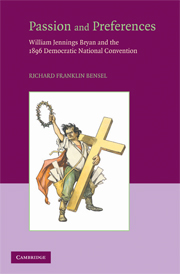8 - The Nomination Contest
Published online by Cambridge University Press: 24 July 2009
Summary
The race for the presidential nomination had several phases. As the race began, the nation's newspapers started to report sentiment for or against the leading possibilities. Many of these stories were based on interviews with local Democratic notables who were attending their respective state party conventions. While some would become delegates to the national convention where their own preferences would become important, most interviews focused on how the various candidates might fare in their states in the general election. Other accounts reported the resources available to particular campaigns and plans for their deployment at the convention. Bland and Boies were the clear leaders in this first stage, with John McLean of Ohio and Claude Matthews of Indiana trailing behind.
The race began to heat up when the delegates started to arrive in Chicago and the presidential campaigns began to mount visible displays in the form of headquarters, marching clubs, bands, and posters. While the size of this deployment also confirmed or disproved previous reports, the sentiment of the delegates became an important factor at this stage. Individual delegates indicated their preferences by wearing the badges of their favorites or endorsing them in interviews with the press. State delegations did the same thing, either announcing the distribution of preferences among their members or formally pledging their support to one of the candidates.
- Type
- Chapter
- Information
- Passion and PreferencesWilliam Jennings Bryan and the 1896 Democratic Convention, pp. 248 - 304Publisher: Cambridge University PressPrint publication year: 2008



